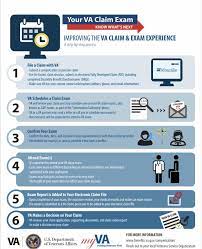Understanding the VA Claim Status Process
When you submit a claim to the Department of Veterans Affairs (VA) for disability compensation or other benefits, it is important to understand the process and how to check the status of your claim.
The VA claim status process can be broken down into several key steps:
- Claim Submission: Once you have submitted your claim, the VA will review all the evidence and documentation provided to determine your eligibility for benefits.
- Evaluation: A VA claims processor will evaluate your claim based on the evidence provided, medical records, and any other relevant information.
- Decision: The VA will make a decision on your claim and notify you of the outcome. This decision can include approval, denial, or requests for additional information.
- Appeal (if necessary): If you disagree with the decision made on your claim, you have the right to appeal. The appeals process can involve multiple stages and may require additional evidence.
To check the status of your VA claim, you can use the VA’s online portal called eBenefits or call the VA’s toll-free number for assistance. It is important to regularly monitor your claim status and respond promptly to any requests for additional information to avoid delays in processing.
Remember that each VA claim is unique, and processing times can vary depending on various factors such as complexity of the case, volume of claims being processed, and availability of supporting documentation.
If you have questions about your VA claim status or need assistance with navigating the process, consider reaching out to a Veterans Service Officer (VSO) or a representative from a veterans’ service organization for guidance.
7 Benefits of the VA Claim Status Process: Empowering Veterans with Transparency and Control
- Provides a clear and transparent process for veterans to apply for benefits.
- Enables veterans to track the progress of their claims online or through phone inquiries.
- Helps veterans understand the status of their claims and any decisions made by the VA.
- Offers an opportunity for veterans to provide additional information or evidence to support their claims.
- Allows veterans to appeal decisions they disagree with, ensuring fair consideration of their cases.
- Assists in reducing wait times by providing updates on claim processing stages.
- Empowers veterans to take control of their benefits application process.
Four Major Pitfalls of the VA Claim Status Process: Delays, Documentation, Confusion, and Communication Issues
- Lengthy Processing Times
- Complex Documentation Requirements
- Confusing Appeals Process
- Inconsistent Communication
Provides a clear and transparent process for veterans to apply for benefits.
The VA claim status process offers a significant advantage by providing veterans with a clear and transparent pathway to apply for benefits. This structured process ensures that veterans understand the steps involved in submitting their claims and allows them to track the progress of their applications easily. By offering transparency, veterans can have confidence in the system and feel informed throughout the application process, ultimately leading to a more efficient and effective way of accessing the benefits they deserve.
Enables veterans to track the progress of their claims online or through phone inquiries.
The VA claim status process offers a significant benefit by allowing veterans to track the progress of their claims conveniently through online platforms or phone inquiries. This feature empowers veterans to stay informed about the status of their claims, providing transparency and reassurance throughout the process. By enabling easy access to real-time updates on their claims, veterans can actively monitor and manage their cases, ensuring timely responses to any requests for additional information and reducing uncertainties regarding the outcome of their claims.
Helps veterans understand the status of their claims and any decisions made by the VA.
One significant advantage of the VA claim status process is that it helps veterans stay informed about the progress of their claims and any decisions made by the Department of Veterans Affairs (VA). By providing regular updates on the status of their claims, veterans can have a clearer understanding of where their case stands and what steps are being taken. This transparency not only empowers veterans to track the progress of their claims but also allows them to be better prepared for any potential outcomes or next steps in the process.
Offers an opportunity for veterans to provide additional information or evidence to support their claims.
One significant advantage of the VA claim status process is that it offers veterans an opportunity to provide additional information or evidence to support their claims. This allows veterans to ensure that all relevant details are considered in the evaluation of their claims, potentially increasing their chances of a favorable outcome. By allowing veterans to supplement their initial submissions with new evidence or documentation, the VA claim status process promotes transparency and fairness in decision-making, ultimately working towards ensuring that veterans receive the benefits they rightfully deserve.
Allows veterans to appeal decisions they disagree with, ensuring fair consideration of their cases.
One significant advantage of the VA claim status process is that it allows veterans to appeal decisions they disagree with, ensuring fair consideration of their cases. This appeals process provides veterans with the opportunity to present additional evidence, clarify misunderstandings, and seek a review of their claims by higher authorities. By having the option to appeal unfavorable decisions, veterans can advocate for their rights and ensure that their cases are thoroughly evaluated, ultimately leading to a more just and equitable outcome.
Assists in reducing wait times by providing updates on claim processing stages.
The VA claim status process offers a valuable benefit by assisting in reducing wait times through providing regular updates on the various stages of claim processing. By keeping claimants informed about where their claim stands in the process, individuals can have a better understanding of the timeline and expectations for their case. This transparency helps to alleviate uncertainty and anxiety associated with waiting for a decision, ultimately leading to a more efficient and streamlined claims process.
Empowers veterans to take control of their benefits application process.
The VA claim status process empowers veterans by allowing them to take control of their benefits application process. By providing transparency and updates on the status of their claim, veterans are able to actively monitor the progress of their application. This proactive approach enables veterans to stay informed, address any issues promptly, and advocate for themselves throughout the entire process. Ultimately, having access to real-time information about their claim status gives veterans a sense of empowerment and ownership over their benefits application journey.
Lengthy Processing Times
One significant con of the VA claim status process is the lengthy processing times, which often result in delays in veterans receiving their entitled benefits. The extensive time it takes for claims to be reviewed, evaluated, and decided upon can be frustrating for veterans who are in need of timely assistance. These delays can further exacerbate financial hardships and medical needs that veterans may be experiencing, highlighting a critical flaw in the system that needs to be addressed to ensure that veterans receive the support they deserve in a more efficient manner.
Complex Documentation Requirements
One significant drawback of the VA claim status process is the complex documentation requirements. Veterans often face challenges in gathering the extensive documentation needed to support their claims. The process may involve obtaining medical records, service records, and other relevant documents, which can be time-consuming and overwhelming for many veterans. Meeting these documentation requirements can be a barrier for some veterans in accessing the benefits they are entitled to, leading to delays and frustrations in the claims process.
Confusing Appeals Process
One significant drawback of the VA claim status process is the confusing appeals process. For veterans looking to challenge a decision made on their claim, navigating the appeals process can be a daunting and overwhelming task. The complexity of the appeals system, which involves multiple stages and requirements for submitting additional evidence, can create barriers for veterans seeking to appeal an unfavorable decision. This confusion can lead to delays in receiving a final resolution on their claims, adding further frustration to an already challenging process for veterans and their families.
Inconsistent Communication
One significant drawback of the VA claim status process is the issue of inconsistent communication. Veterans often face difficulties in obtaining clear and consistent updates regarding the status of their claims. This lack of reliable communication can lead to confusion, frustration, and delays in the processing of benefits. Without consistent information about the progress of their claims, veterans may feel uncertain about the next steps to take or how long it will take to receive a decision. Improved communication channels and transparency in providing updates could greatly enhance the overall experience for veterans navigating the VA claim process.




